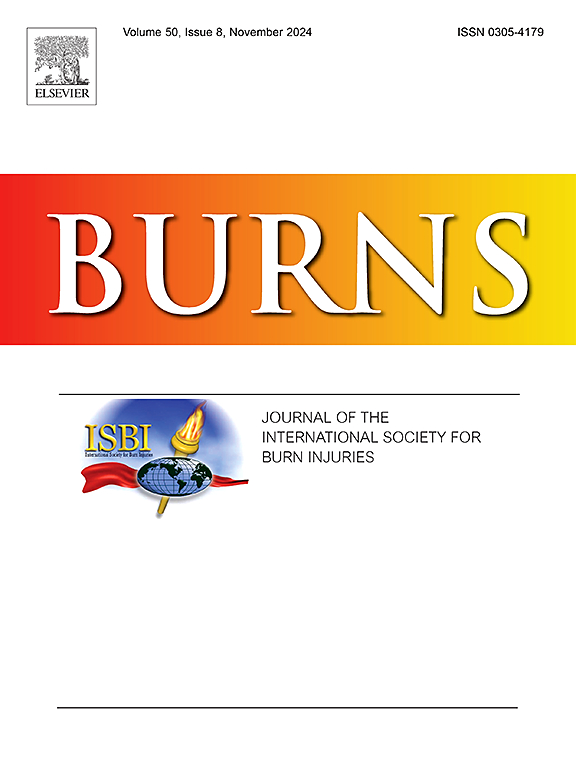Management of operating theatre ambient temperature for major burn patients in a state-wide adult burns centre
IF 3.2
3区 医学
Q2 CRITICAL CARE MEDICINE
引用次数: 0
Abstract
Introduction
The aim of this study was to investigate the efficacy of limiting increases in theatre ambient temperature to 27°C to prevent intraoperative patient hypothermia. METHODS: This single-centre, comparative cohort clinical study investigated the management of theatre ambient temperatures involving patients with ≥ 20 % TBSA burn injuries at Victorian Adult Burns Service (Melbourne, Australia). Data from the intervention group (August 2021 - February 2023, theatre ambient temperature increase limited to 27°C) was compared with a historical cohort (August 2019 - August 2021). Patient hypothermia was defined as core temperature below 36°C. RESULTS: In total, 29 patients underwent 107 surgical procedures in the operating theatre. Patient hypothermia was recorded on 45 occasions (42.1 %) and of these, between 35.1 and 36.0°C on 28 occasions (62.2 %). There was no statistically significant difference in the incidence of hypothermia, hospital LOS, ICU LOS, total operations, or mortality between the study cohort and historical cohort. Patients who suffered hypothermia had lower BMI, lower preoperative temperature, and shorter ICU LOS. CONCLUSION: Increasing theatre ambient temperature to 27°C is adequate in most cases. A more nuanced approach with selective increase of theatre ambient temperature beyond 27°C, only where clinically indicated, is a refinement that will benefit both patients and staff.
全国成人烧伤中心重大烧伤患者手术室环境温度的管理。
本研究的目的是探讨限制手术室环境温度升高至27°C以防止术中患者体温过低的效果。方法:这项单中心、比较队列临床研究调查了维多利亚成人烧伤服务中心(墨尔本,澳大利亚)对≥ 20 % TBSA烧伤患者的手术室环境温度管理。将干预组(2021年8月至2023年2月,手术室环境温度升高限制在27°C)的数据与历史队列(2019年8月至2021年8月)进行比较。患者体温过低定义为核心温度低于36°C。结果:29例患者共行107例手术。患者体温过低记录45次(42.1 %),其中28次(62.2 %)在35.1至36.0°C之间。研究队列与历史队列在低体温发生率、医院LOS、ICU LOS、总手术量或死亡率方面无统计学差异。低体温患者BMI较低,术前体温较低,ICU LOS较短。结论:在大多数情况下,将手术室环境温度提高到27°C就足够了。一种更细致的方法是选择性地将手术室环境温度提高到27°C以上,仅在临床指诊时,这是一种对患者和工作人员都有益的改进方法。
本文章由计算机程序翻译,如有差异,请以英文原文为准。
求助全文
约1分钟内获得全文
求助全文
来源期刊

Burns
医学-皮肤病学
CiteScore
4.50
自引率
18.50%
发文量
304
审稿时长
72 days
期刊介绍:
Burns aims to foster the exchange of information among all engaged in preventing and treating the effects of burns. The journal focuses on clinical, scientific and social aspects of these injuries and covers the prevention of the injury, the epidemiology of such injuries and all aspects of treatment including development of new techniques and technologies and verification of existing ones. Regular features include clinical and scientific papers, state of the art reviews and descriptions of burn-care in practice.
Topics covered by Burns include: the effects of smoke on man and animals, their tissues and cells; the responses to and treatment of patients and animals with chemical injuries to the skin; the biological and clinical effects of cold injuries; surgical techniques which are, or may be relevant to the treatment of burned patients during the acute or reconstructive phase following injury; well controlled laboratory studies of the effectiveness of anti-microbial agents on infection and new materials on scarring and healing; inflammatory responses to injury, effectiveness of related agents and other compounds used to modify the physiological and cellular responses to the injury; experimental studies of burns and the outcome of burn wound healing; regenerative medicine concerning the skin.
 求助内容:
求助内容: 应助结果提醒方式:
应助结果提醒方式:


